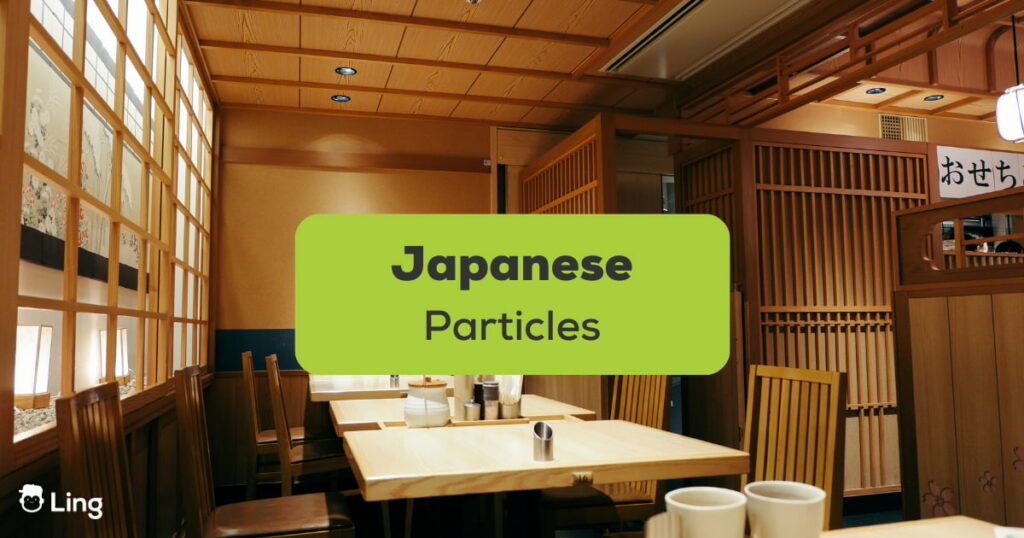Konnichiwa! (こんにちは) Today, we are greeting you with the typical Japanese expression, which means “hello.” We are excited to warm you up before brushing up on the Japanese particles lesson together. So how is your Japanese level so far?
If you are someone who keeps memorizing basic Japanese vocabulary but has no idea how to connect it, it is time to push yourself to the upper level by learning Japanese particles. Let’s learn more Japanese with these lessons.
A Guide To The Common Japanese Particles
There are heaps of Japanese particles to remember. But do not give up yet; you can focus on the commonly used particles and spare time for other particles in the future.
| Japanese | Sound | Japanese | Sound | Japanese | Sound | Japanese | Sound | Japanese | Sound |
|---|---|---|---|---|---|---|---|---|---|
| は [wa] | を [wo] | の [no] | も [mo] | と [to] | |||||
| か [ka] | が [ga] | から [kara] | まで [made] | や [ya] | |||||
| へ [e] | で [de] | よ [yo] | ね [ne] | に [ni] |
Don’t know where to start with these particles? Practice some words and phrases on the Ling app by downloading it on the Play Store or App Store now!
1. Particle は [Wa]
When you enter the Japanese language world, this particle is undoubtedly the first one you meet. It is a subject marker.
Example Sentence
2. Particle を [Wo] – Pronounced “O”
The direct object particle indicates what receives the action of the verb in Japanese. This is one of the most common Japanese particles because you will always use it.
Example Sentence
3. Particle の [No]
This particle is a subject marker to indicate that something belongs to someone.
Example Sentence
4. Particle も [Mo]
This particle simply replaces は (wa) when you want to comply with something.
Example Sentence
5. Particle と [To]
Its role is to connect two Japanese nouns together when they take that action at the same time.
Example Sentence

6. Particle に [Ni]
It indicates the time and location where an action takes place.
Example Sentence
7. Particle へ – Pronounced [え : e]
It is slightly different from に (ni), but へ (e) is more specific on the spot where you are (exactly) going.
Example Sentence
8. Particle か [Ka]
This particle indicates the question word and must be put at the end of a sentence.
Example Sentence
9. Particle が [Ga]
It can be used to indicate something’s condition, and it is an adjective marker.
Example Sentence

10. Particle で [De]
This particle indicates where your movement takes place, for example, work at the company, exercise at the gym, dance in the park, etc.
Example Sentence
11. Particle から [Kara]
It simply means “from,” indicating the origin of that action.
Example Sentence
- タイから日本まで約6時間かかる。 (Tai kara nihon made yaku rokujikan kakaru)
From Thailand to Japan take around 6 hours.
12. Particle まで [Made]
If から (kara) means “from”, so まで (made) means “to”. It indicates the destination where the action is ended.
Example Sentence
- タイから日本まで約6時間かかる。 (Tai kara nihon made yaku rokujikan kakaru)
From Thailand to Japan take around 6 hours.
13. Particle や [Ya]
It works by giving examples, (…and…), but it is placed between each sample the speaker provides.
Example Sentence
- 赤や青や黄色が混じり合っている。 (aka ya ao ya kiiro ga majiri atte iru)
Red, blue, yellow, and other colors are mixed.
14. Particle よ [Yo]
This particle is always put at the end of a sentence. It is used to highlight the word you express and make it clear.
Example Sentence
15. Particle ね [Ne]
It works the same way as よ (yo), but this particle expresses a softer feeling.
Example Sentence
- 今日はいい天気だね。 (kyou wa ii tenki da ne)
The weather is good today. - 僕はこの歌が嫌いだね。 (boku wa kono uta ga kirai da ne)
I hate this song.

Why Should We Learn Japanese Particles?
Though remembering Japanese words and phrases can help you survive when traveling to Japan, learning how to structure them into a complete sentence can undoubtedly help you to get the most out of your experience. You do not have to be a total native speaker overnight, but it would be wise if you could try to express トイレはどこですか? (toire wa doko desu ka), “where is the toilet?” than just sayingトイレ (to-i-re) to the locals.
Although simple, using the above example will make you sound so eloquent and ensure that there will be no misinterpretation between you and the Japanese. After all, the Japanese language is so complex that tons of words and expressions may sound the same yet have different meanings depending on the context.
What Is The Basic Japanese Grammar Rule?
From there, if you want to master creating Japanese sentences, it is necessary to understand Japanese grammar rules. First, the Japanese language has a subject, verb, and object like other languages. However, Japanese sentences are uniquely ordered. Instead of ordering from subject-verb-object, in Japanese, verbs come at the end of a sentence. For example;
Subject + Particle + Object + Particle + Verb
Besides the Japanese sentence structure, you must change verb tenses when discussing the present and past. But one thing that can be used to judge if you speak broken grammar is Japanese particles. Also, if you look closely at the sentence above, there are two particles in the sentence. Japanese particles play a key role in indicating words within a sentence. They are small words but make a sentence complete and clear.
How Will You Practice Japanese Particles?
You probably realize now that it is so beneficial to learn Japanese particles as they are really handy when it comes to stringing together a complete sentence. Basically, they pave the way for better communication.
However, the Japanese language has over 180+ particles, so we urge you to at least familiarize yourself with the basic ones covered in this post. Also, try to practice at least one Japanese particle daily because, bit by bit, every day is more productive than ever.
Learn Japanese Particles With The Ling App
Do you know that the Ling app offers you valuable features and complete lessons for Japanese and 60+ other languages? The application is so unique that it will even help you get acquainted with the Japanese accent by listening to recordings of real native speakers. In addition, the lessons from the inside come with an impressive number of vocabulary and expressions that are used in daily life.
If you need to practice more conveniently, there’s nothing that we can recommend more than to learn the Japanese language with the Ling app. What are you waiting for? Download it today and start learning Japanese and other foreign languages right away!


































































